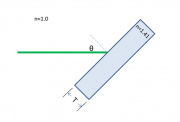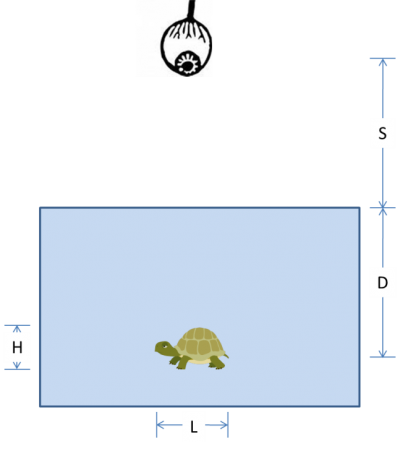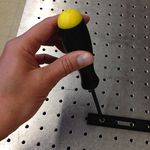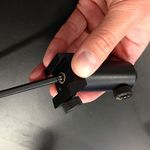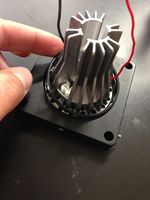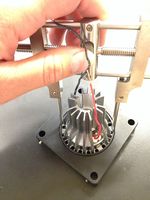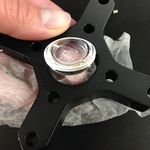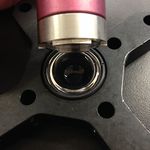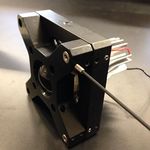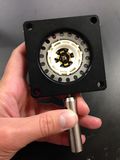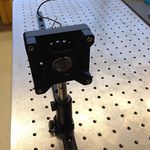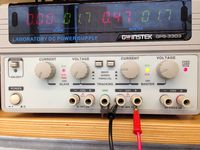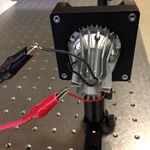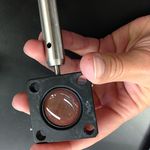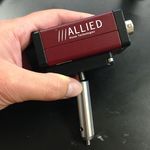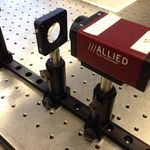Difference between revisions of "Optics Bootcamp"
(→Problems) |
|||
| Line 33: | Line 33: | ||
===Snell's law=== | ===Snell's law=== | ||
[[File:Optics bootcamp snells law problem.png|thumb|right]] | [[File:Optics bootcamp snells law problem.png|thumb|right]] | ||
| − | A laser beam shines on to a rectangular piece of glass with thickness T at an angle <math>\theta</math> of 45° from the surface normal, as shown in the diagram. The index of refraction of the glass, ng, is 1.41 ≈√2. The index of refraction for air is 1.00. | + | A laser beam shines on to a rectangular piece of glass with thickness T at an angle <math>\theta</math> of 45° from the surface normal, as shown in the diagram. The index of refraction of the glass, ng, is 1.41 ≈√2. The index of refraction for air is 1.00. <br> |
| − | + | (a) At what angle does the beam emerge from the back of the glass? <br> | |
| − | + | (b) When the beam emerges, in what direction (up or down) and by how much will it be displaced from its original axis of propagation? | |
| Line 41: | Line 41: | ||
[[File:Turtle problem.png|center|400 px]] | [[File:Turtle problem.png|center|400 px]] | ||
| − | In the diagram above, an observer at height S above the surface of the water looks straight down at a turtle swimming in a pool. The turtle has length L, height H, and swims at depth D. | + | In the diagram above, an observer at height S above the surface of the water looks straight down at a turtle swimming in a pool. The turtle has length L, height H, and swims at depth D. <br> |
| − | + | (a) Use ray tracing to locate the image of the turtle. Show your work. <br> | |
| − | + | (b) Is the image real or virtual? <br> | |
| − | + | (c) Is the image of the turtle deeper, shallower, or the same depth as its true depth, D? <br> | |
| − | + | (d) Is the image of the turtle longer, shorter, or the same length as its true length, L? <br> | |
| − | + | (e) Is the image of the turtle taller, squatter, or the same height as its true height, H? | |
| − | === | + | ===Ray tracing with lenses=== |
[[File:RayTracing1.png|center|500 px]] | [[File:RayTracing1.png|center|500 px]] | ||
| − | Lenses L1 and L2 have focal lengths of f1 = 1 cm and f2 = 2 cm. The distance between the two lenses is 7 cm. Assume that the lenses are thin. The diagram is drawn to scale. (The gridlines are spaced at 0.5 cm.) Note: You might want to print out this diagram so you can trace the rays directly onto it. | + | Lenses L1 and L2 have focal lengths of f1 = 1 cm and f2 = 2 cm. The distance between the two lenses is 7 cm. Assume that the lenses are thin. The diagram is drawn to scale. (The gridlines are spaced at 0.5 cm.) Note: You might want to print out this diagram so you can trace the rays directly onto it. <br> |
| − | + | ||
| − | + | ||
| − | + | ||
| − | + | ||
| − | + | ||
| + | (a) Use ray tracing to determine the location of the image. Indicate the location on the diagram. How far to the right of lens L2 is the image located? <br> | ||
| + | (b) Is the image upright or inverted? Is the image real or virtual? Explain. <br> | ||
| + | (c) What is the magnification of this system? <br> | ||
| + | (d) Lens L1 is made of BK7 glass with a refractive index n1 of 1.5. Lens L2 is made of fluorite glass with a refractive index n2 of 1.4. Compute the focal lengths of L1 and L2 if they are submerged in microscope oil (refractive index no = 1.5). | ||
==Gather materials== | ==Gather materials== | ||
Revision as of 18:38, 1 February 2016
Overview
You are going to build a microscope next week. The goal of the Optics Bootcamp exercise is to make that seem like a less intimidating task.
The Bootcamp starts with a few ray optics problems. After you do the problems, you will build an imaging apparatus made from some of the same optical components you will use in the microscopy lab. The apparatus includes an LED illuminator, an object with precisely spaced markings, a lens, and a CCD camera. You will compare measurements you make in lab of the object distance, image distance, and magnification to the values predicted by the lens makers' formula that was covered in class. Do the problems ahead of time or come in to the lab if you would like some help. Then go ahead do the lab work.
And let's be careful out there. (This is a reference to a TV series that originally aired probably about a decade before you were born.)
Problems
Snell's law
A laser beam shines on to a rectangular piece of glass with thickness T at an angle $ \theta $ of 45° from the surface normal, as shown in the diagram. The index of refraction of the glass, ng, is 1.41 ≈√2. The index of refraction for air is 1.00.
(a) At what angle does the beam emerge from the back of the glass?
(b) When the beam emerges, in what direction (up or down) and by how much will it be displaced from its original axis of propagation?
Chelonian size estimation
In the diagram above, an observer at height S above the surface of the water looks straight down at a turtle swimming in a pool. The turtle has length L, height H, and swims at depth D.
(a) Use ray tracing to locate the image of the turtle. Show your work.
(b) Is the image real or virtual?
(c) Is the image of the turtle deeper, shallower, or the same depth as its true depth, D?
(d) Is the image of the turtle longer, shorter, or the same length as its true length, L?
(e) Is the image of the turtle taller, squatter, or the same height as its true height, H?
Ray tracing with lenses
Lenses L1 and L2 have focal lengths of f1 = 1 cm and f2 = 2 cm. The distance between the two lenses is 7 cm. Assume that the lenses are thin. The diagram is drawn to scale. (The gridlines are spaced at 0.5 cm.) Note: You might want to print out this diagram so you can trace the rays directly onto it.
(a) Use ray tracing to determine the location of the image. Indicate the location on the diagram. How far to the right of lens L2 is the image located?
(b) Is the image upright or inverted? Is the image real or virtual? Explain.
(c) What is the magnification of this system?
(d) Lens L1 is made of BK7 glass with a refractive index n1 of 1.5. Lens L2 is made of fluorite glass with a refractive index n2 of 1.4. Compute the focal lengths of L1 and L2 if they are submerged in microscope oil (refractive index no = 1.5).
Gather materials
Before you get started, take a little time to learn your way around the lab. This page gives an overview of all the wonderful resources in the lab.
The first step is to gather the materials required to build the lens measuring apparatus. The lists below include part numbers and descriptive names of all the components in the apparatus. It is likely that you will find some of the terms not-all-that-self-explanatory. Most of the parts are manufactured by a company called ThorLabs. If you have a question about any of the components, the ThorLabs website can be very helpful. For example, if the procedure calls for an SPW602 spanner wrench and you have no idea what such a thing might look like, try googling the term: "thorlabs SPW602". You will find your virtual self just a click or two away from a handsome photo and detailed specifications.
Optomechanics
These components are located in plastic bins on top of the center parts cabinet:
- 1 x RLA1800 dovetail optical rails
- 4 x RC1 rail carriers
- 1 x SM1L10 lens tube
- 1 x SM1RC lens tube slip ring
- 1 x CP02 cage plate
- 1 x LCP01 cage plate (looks like an "O" in a square)
- 1 x LCP02 cage plate adapter (looks like an "X")
- 2 x SM2RR retaining rings
These components are located on the counter above the west drawers.
- 4 x ER1 cage assembly rod (The last digit of the part number is the length in inches. Take a 1" rod. Lengths less than 1" have a part number that starts with a zero.)
- 6 x SM1RR retaining rings
Screws and posts
Stainless steel, ¼-20 size, socket head cap screws (SHCS), washers, posts, and post holders are located on top of the west parts cabinet. If you are unfamiliar with screw types, take a look at the main screw page on the McMaster-Carr website. Notice on the left side of the page that there are about ... links on the left side of the page. Click the links for more information about screw sizes and attributes. This link will take you to an awesome chart of SHCS sizes.
- 4 x PH2 post holders
- 4 x TR2 optical posts
- 4 x 8-32 set screws
- 6 x 1/4-20 x 5/16" socket cap screws
- 1 x 1/4-20 set screw
Optics
Lenses and microscope objectives are located in the west drawers.
- 1 x LA1951 plano-convex, f = 25 mm lens
- 1 x LB1811 biconvex, f = 35 mm lens
Object
Imaging targets are located in a plastic bin on top of the east cabinet.
- 1 x R1DS1N 1951 USAF test target
Optoelectronics
LEDs will be in a plastic bin on top of the center cabinet.
- 1 x red, super-bright LED (mounted)
Tools
Most of the tools are located in the drawers at your lab station. Be sure to put all of the tools you use back in their proper location.
Hex keys (also called Allen wrenches) are used to operate SHCSs. Some hex keys have a flat end and others have a ball on the end, called balldrivers. The ball makes it possible to use the driver at an angle to the screw axis, which is very useful in tight spaces. You can get things tighter (and tight things looser) with a flat driver.
- 1 x 3/16 hex balldriver for 1/4-20 cap screws
- 1 x 9/64 hex balldriver
- 1 x 0.050" hex balldriver for 4-40 set screws (tiny)
- 1 x SPW602 spanner wrench
You will also need to use an adjustable spanner wrench. The adjustable spanner resides at the lens cleaning station. There is only one of these in the lab. It is likely that one of your classmates neglected to return it to the proper place. This situation can frequently be remedied by yelling, "who has the adjustable spanner wrench?" at the top of your lungs. Try not to use any expletives. And please return the adjustable spanner wrench to the lens cleaning station when you are done.
- 1 x SPW801 adjustable spanner wrench
Things that should already be (and stay at) your lab station
- 1 x Manta CCD camera
- 1 x Calrad 45-601 power adapter for CCD
- 1 x ethernet cable connected to the lab station computer
Build the apparatus
Visualize, capture, and save images in Matlab
Now that you've learned the basics of mounting, aligning and adjusting optical components, you will through this lab exercise
- verify the lens maker and the magnification formulae:
- $ {1 \over S_o} + {1 \over S_i} = {1 \over f} $
- $ M = {h_i \over h_o} = {S_i \over S_o} $
- become familiar with image acquisition and distance measurement using the Matlab software.
Examine images in Matlab

|
|
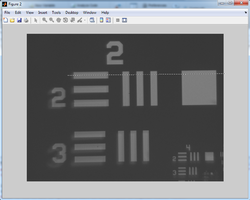
|
|

|
Plot and discuss your results
- Repeat these measurements of $ S_o $, $ S_i $, $ h_o $, and $ h_i $ for several values of $ S_o $.
- Plot $ {1 \over S_i} $ as a function of $ {1 \over f} - {1 \over S_o} $.
- Plot $ {h_i \over h_o} $ as a function of $ {S_i \over S_o} $.
- What sources of error affect your measurements?
- Given the sources of error, how far off could your measurements of magnification be?
Once you are done with your measurements, please clean up and put back all the parts.
Optical microscopy lab
Code examples and simulations
- Converting Gaussian fit to Rayleigh resolution
- MATLAB: Estimating resolution from a PSF slide image
- Matlab: Scalebars
- Calculating MSD and Diffusion Coefficients


